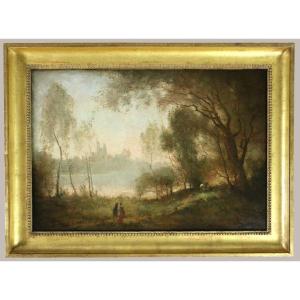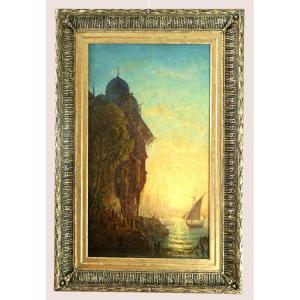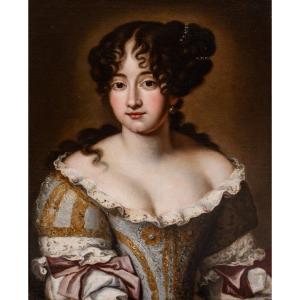Relined canvas measuring 48.5 cm by 38.5 cm.
Important old carved wooden frame measuring 72 cm by 58 cm.
This very beautiful portrait attributed to Pierre Mignard shows us a young man with an untied tie, which suggests the person of an artist or a close friend. The work is superbly framed by a period frame, entirely carved.
Pierre Mignard (1612-1695)
Born in Troyes, Pierre Mignard did his apprenticeship in Bourges, from 1622, with the altar painter Jean Boucher, then in Paris with Simon Vouet. These two painters who had previously traveled to Italy may have communicated to Mignard the desire to travel beyond the mountains. We know very little about his long stay in Italy, mainly in Rome, from 1634-1635 to 1657 (he made a trip to Parma, Modena and Venice in 1654-1655). His real training was under the aegis of Bolognese painting: Annibale Carracci, Domenichino, Alban; he also retained from Correggio his sense of chiaroscuro and meditated on Poussin's painting. We are therefore dealing with an eclectic painter. He returned to Paris at the request of Louis XIV in 1657; he then carried out several commissions, such as the dome of the Val-de-Grâce (1663). A renowned portrait painter, he knew how to flatter the model, but also to mix expression with grace in light and fresh tones, the opposite of the majesty of Le Brun. On the death of his rival (1690), he succeeded him as first painter to the king and director of the Gobelins factory. Long excluded from royal construction sites, he was finally able to execute large decorations, first for the Duke of Orléans at Saint-Cloud (1677-1680, destroyed but partly engraved by J.-B. de Poilly; this ensemble was completed by a Pietà, painted for the chapel of the castle in 1682, today in the church of Sainte-Marie-Madeleine de Gennevilliers), for the Grand Condé (Andromède, 1679, Louvre), then for Monseigneur at Versailles (1683-84), and finally for Louis XIV himself: in 1685, he painted the ceilings of the Petite Galerie (engraved by G. Audran) and the 2 salons that accompany it. All these ceilings were unfortunately destroyed; or, they formed the part that the painter himself considered the most important of his work. Supported by Louvois, Mignard gradually supplanted Le Brun, with whom he led an open struggle. Episodes of this struggle, a Carrying of the Cross offered to the king in 1684 (Louvre), a Family of Darius (Ermitage) which rivaled in 1689 with the painting that had once made Le Brun famous. On the latter's death (1690), Mignard, almost octogenarian, succeeded him in his responsibilities and dignities and displayed incredible activity. He multiplied projects for the decoration of the church of the Invalides (drawings in the Louvre), undertook 2 ceilings for the king's small apartment at Versailles (fragments in the museums of Grenoble, Lille, Toulouse, Dinan, at the castle of Fontainebleau) and painted a series of religious paintings.






































 Le Magazine de PROANTIC
Le Magazine de PROANTIC TRÉSORS Magazine
TRÉSORS Magazine Rivista Artiquariato
Rivista Artiquariato